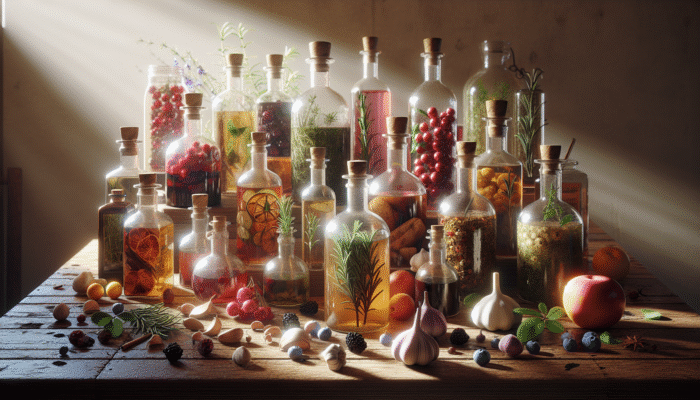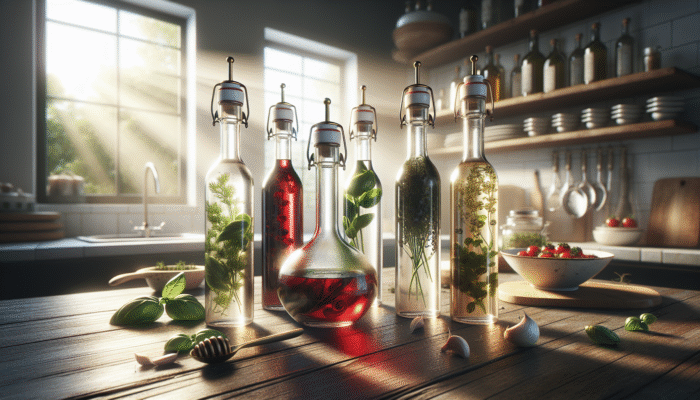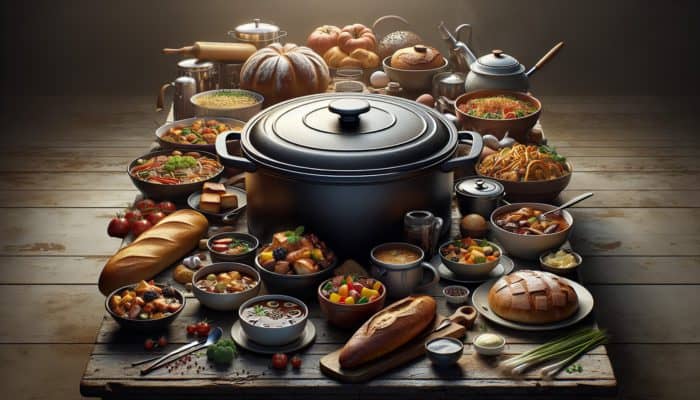Selecting the Perfect Herbs for Flavorful Aromatic Vinegar Infusions
Discover the Best British Herbs for Creating Exquisite Vinegar Infusions

In the world of gastronomy, the choice of herbs is crucial, and the UK offers a stunning variety of aromatic herbs perfect for crafting delightful vinegar infusions. Notable garden herbs such as rosemary, thyme, and mint flourish in British gardens, enhancing the taste profiles of vinegars with their aromatic properties. The unique, pine-like fragrance of rosemary pairs wonderfully with cider vinegar, creating a tangy yet fragrant infusion that elevates dishes like salad dressings and roasted vegetables. On the other hand, thyme imparts a subtle herbal flavor that beautifully balances the acidity of malt vinegar, making it an excellent selection for marinades and drizzles.
Mint, known for its refreshing and invigorating flavor, is particularly popular for summer infusions. When combined with white wine vinegar, it produces a crisp and revitalizing infusion, ideal for enhancing not only culinary dishes but also cocktails. Additionally, herbs like chives and basil can be blended together to create distinctive combinations that appeal to the British palate, transforming traditional recipes into modern culinary masterpieces. When choosing herbs, it's vital to think about their flavor characteristics and the intended use of the vinegar, ensuring a delightful and harmonious pairing that elevates your culinary creations.
Understanding the Seasonal Availability of Herbs for Flavorful Infusions
The success of herbal vinegar infusions is closely tied to seasonal cycles, making it essential to know when to harvest herbs in the UK. Spring marks the emergence of fresh herbs, with rosemary and thyme reaching their flavor peak from late spring through early summer. During these months, these herbs release a more intense aroma, making them ideal candidates for infusion. By summer, vibrant herbs like mint and basil are flourishing, offering a diverse range of flavors that can be beautifully incorporated into vinegar.
As autumn approaches, another opportunity arises to gather resilient herbs that can withstand cooler temperatures. By late autumn, hardy herbs like sage and parsley remain robust, providing options for creative infusions as the year wraps up. Gaining a thorough understanding of seasonal cycles not only enhances flavor but also encourages sustainable practices in growing and foraging herbs. By timing your infusion practices with the natural availability of herbs, you can create vinegars that authentically capture the essence of each season in the UK.
Creating Unique Herb Combinations for Exceptional Vinegar Infusions
Exploring herb combinations opens up a world of flavor possibilities for vinegar infusions, especially within the vibrant UK culinary scene. Timeless pairings, such as rosemary and garlic, create a fragrant infusion that complements roasted meats and vegetables perfectly. Alternatively, combining thyme with lemon zest introduces a zesty dimension, making it a fantastic option for dressings or marinades.
For the adventurous palate, consider mixing herbs with a touch of fruit or spice. For example, combining mint with strawberries yields a refreshing vinegar that’s perfect for summer salads or desserts. Furthermore, experimenting with herbs like dill and coriander can add a unique twist, particularly in dressings for fish or Mediterranean-inspired dishes. The creative possibilities are endless, and by exploring various herb combinations, you can craft personalized infusions that express your culinary style and creativity.
Exploring Different Types of Vinegar for Flavorful Herbal Infusions

Utilising Cider Vinegar for Bright and Flavorful Herbal Infusions
Cider vinegar has emerged as a staple in UK kitchens, valued not just for its numerous health benefits but also for its remarkable compatibility with various herbs during infusions. The natural sweetness of apple cider vinegar blends seamlessly with a variety of herbs, resulting in lively herbal infusions. This distinctive quality makes cider vinegar an excellent choice for those looking to create vibrant and flavorful herbal blends. The inherent acidity of cider vinegar ensures that the bold flavors of herbs like rosemary and thyme remain prominent while balancing the sweetness with a refreshing tang.
Moreover, cider vinegar is widely available in local supermarkets and farmers' markets, making it a convenient option for home cooks. Its versatility extends beyond herbal infusions; it can also be used in dressings, marinades, and even health tonics, further enhancing its appeal. Crafting a herbal vinegar infusion with cider vinegar not only delivers a delightful culinary experience but also fosters a connection to local agricultural practices, as many apple orchards dot the UK landscape.
Delving into the Rich Flavor Profile of Malt Vinegar
Renowned for its strong and distinctive flavor, malt vinegar is a cherished ingredient in UK kitchens, especially in iconic meals like fish and chips. This vinegar, derived from barley, imparts a rich, malty undertone to herbal infusions, transforming everyday meals into extraordinary culinary experiences. When infused with herbs like thyme or bay leaves, malt vinegar develops a complex flavor profile, making it ideal for drizzling over hearty dishes or incorporating into marinades.
Malt vinegar is particularly suitable for creating infusions with traditional British herbs, capturing the essence of home-cooked meals. Its deep hue and robust flavor also make it a popular choice for pickling, allowing the infusion to serve dual purposes: as a flavorful addition to meals and as a means of preserving seasonal produce. By harnessing the unique qualities of malt vinegar, home cooks can explore a multitude of flavor combinations that resonate deeply with British culinary heritage.
Enhancing Culinary Creations with Sophisticated Wine Vinegar Infusions

Wine vinegar, especially the red and white varieties, represents a refined choice for herbal infusions, elevating the finished product to new culinary standards. The acidity of wine vinegar pairs exceptionally well with herbs, resulting in balanced infusions that enhance salads, sauces, and even cocktails. For instance, combining white wine vinegar with herbs like basil or chervil creates a bright and fresh infusion, perfect for summer salads or delicate seafood dishes.
In contrast, red wine vinegar harmonizes beautifully with robust herbs such as rosemary and oregano, imparting a deep quality to marinades and dressings. Utilizing wine vinegar in infusions highlights the sophistication of British culinary traditions, where the fusion of flavors can yield truly exceptional dishes. Mastering infusion techniques with wine vinegar opens up a world of gourmet cooking possibilities right in your kitchen.
Creating Luxurious Infusions with Balsamic Vinegar
Balsamic vinegar, known for its rich sweetness and complex flavor, holds a prestigious position in the realm of herbal vinegar infusions. Often associated with fine dining, it provides a sumptuous base for infusions, allowing herbs to shine without overpowering their delicate characteristics. The intricate nature of balsamic vinegar makes it a perfect partner for herbs like sage or rosemary, resulting in a beautifully layered infusion that can transform simple dishes into extraordinary culinary experiences.
Incorporating balsamic vinegar into herbal infusions also encourages creative experimentation. Infusing balsamic with herbs and fruits, such as figs or blackberries, can yield decadent results that are ideal for drizzling over cheeses or roasted meats. The versatility of balsamic vinegar ensures its enduring popularity in kitchens across the UK, allowing chefs to explore diverse flavor combinations that suit various occasions.
Mastering Infusion Techniques for Maximum Flavor Extraction
Implementing the Cold Infusion Method for Pure Herbal Extracts
The cold infusion method is a widely embraced technique in the UK, allowing the pure essence of herbs to be captured in vinegar while preserving their delicate flavors. This approach involves immersing fresh herbs in vinegar and allowing them to steep without applying heat, typically for several weeks. A key factor in achieving a successful cold infusion is selecting high-quality herbs and the right vinegar, ensuring that the final product reaches the desired flavor profile.
When using the cold infusion method, it is essential to choose herbs that maintain their flavors over time. For example, robust herbs like rosemary and thyme are ideal candidates due to their ability to withstand prolonged steeping. A common practice involves placing the herbs directly into a clean glass jar filled with vinegar, sealing it tightly, and storing it in a cool, dark location. Regularly shaking the jar helps ensure that the flavors meld beautifully, leading to an infusion that captures the vibrant essence of the chosen herbs.
One significant advantage of the cold infusion method is its simplicity and minimal energy consumption, making it an environmentally friendly approach to flavoring vinegar. Moreover, this technique is particularly well-suited for those eager to experiment with various herb combinations, empowering home cooks to develop unique flavors tailored to their culinary preferences. The resulting herbal vinegar can be utilized in dressings, marinades, or as a finishing touch, showcasing the depth and complexity achieved through this method.
Accelerating Flavor Extraction with the Warm Infusion Method
For those seeking a faster route to flavorful herbal vinegar, the warm infusion method offers an effective solution. By gently heating the vinegar alongside the herbs, this technique expedites flavor extraction, yielding a vibrant infusion within hours rather than weeks. However, it is crucial to find the right balance when applying heat, as excessive temperatures can compromise the subtle nuances of certain herbs.
To utilize the warm infusion method, start by heating your chosen vinegar in a saucepan until it reaches a gentle simmer. Once heated, add the herbs, ensuring they are fully submerged. Maintaining a low temperature allows the flavors to meld without cooking the herbs, which could lead to bitterness. After simmering briefly, remove the mixture from heat and allow it to cool before straining out the herbs. The result is a lively herbal vinegar that preserves the freshness of the herbs while delivering robust flavor.
This method is particularly beneficial for those pressed for time yet eager to create unique blends. By experimenting with various herbs and vinegar types, home cooks can craft an impressive array of infused vinegars in a fraction of the time required for cold infusions. The resulting warm-infused vinegars can be used in diverse dishes, adding a burst of flavor that enhances everyday meals.
Employing Eco-Friendly Solar Infusion Techniques for Herbal Vinegars
Leveraging solar energy, the solar infusion method presents an eco-friendly and visually appealing approach to crafting herbal vinegar infusions. This technique involves placing herbs and vinegar in a clear glass jar and allowing the sun’s rays to gently warm the mixture, gradually extracting flavors over time. The solar infusion method not only provides a delightful sensory experience but also fosters a connection to nature and the environment.
To begin, fill a glass jar with your selected vinegar and add fresh herbs, ensuring they are adequately submerged. Seal the jar tightly and position it in a sunny spot, allowing the sun’s warmth to work its magic over several days or weeks. The gentle heating accelerates the infusion process without compromising the character of the herbs, resulting in beautifully flavored herbal vinegar. It is essential to monitor the infusion periodically, gently shaking the jar to ensure even extraction.
A unique aspect of the solar infusion method is its sustainability, as it relies solely on natural sunlight rather than energy-intensive heating processes. This aligns with the growing interest in eco-friendly cooking practices among UK consumers. The final product captures not only the flavors of the selected herbs but also the essence of the season, making it a wonderful conversation starter in your culinary creations. As you explore solar infusions, you can experiment with various herb combinations, breathing new life into your cooking repertoire.
Determining the Optimal Duration for Infusion to Achieve Maximum Flavor
Quick Short-Term Infusions for Instant Flavor Enhancement
Short-term infusions offer a practical option for those desiring quick results without sacrificing flavor. Typically steeping for one to two days, these infusions allow the vibrant characteristics of the herbs to impart their essence into the vinegar swiftly. This method is particularly popular among home cooks looking to create quick dressings or marinades that can elevate meals without extensive preparation.
In the UK, short-term infusions are especially effective with herbs that possess a strong flavor profile but may lose their potency over time. Herbs such as mint and chives are well-suited for this method, as their bright flavors can infuse vinegar quickly and effectively. To carry out a short-term infusion, combine your chosen herbs with vinegar in a clean glass jar, seal it tightly, and allow it to sit at room temperature for a couple of days. Shaking the jar regularly helps circulate the flavors, ensuring an even infusion.
Once the infusion period concludes, strain out the herbs, and your vibrant herbal vinegar is ready for use. This method not only saves time but also encourages experimentation with diverse flavor combinations, enabling home cooks to adapt to seasonal herbs or personal tastes. The resulting infused vinegar can be utilized in numerous ways, from salad dressings to marinades, imparting a burst of freshness to everyday meals.
Exploring the Depth of Medium-Term Infusions
Medium-term infusions, typically lasting from one to four weeks, strike an ideal balance between flavor depth and convenience. This duration allows for a thorough extraction of the herbs’ essence, resulting in a well-rounded vinegar that boasts complexity and richness. This method is especially advantageous for herbs that require more time to fully release their flavors, such as thyme and oregano.
When employing the medium-term infusion method, start by selecting your preferred herbs and placing them in a clean glass jar. Pour your chosen vinegar over the herbs, ensuring they are entirely submerged, and seal the jar tightly. Store it in a dark, cool location, allowing the flavors to meld over several weeks. Shaking the jar occasionally promotes the infusion process, enhancing the development of flavor.
The charm of medium-term infusions lies in their versatility. Home cooks can experiment with diverse herb combinations and vinegar types, customizing their infusions to suit specific recipes or occasions. Once the infusion period is complete, strain out the herbs, and the resulting herbal vinegar can be used in dressings, marinades, or as a flavor enhancer in various dishes. This method encourages a deeper exploration of flavors while remaining manageable for those with busy schedules.
Developing Rich Flavors with Long-Term Infusions
Long-term infusions are a treasured technique among culinary enthusiasts, allowing for the creation of deeply flavored herbal vinegars over extended periods. Typically spanning one month to several months, this method is ideal for those wishing to develop complex infusions that evolve in flavor and character. Herbs with robust profiles, such as sage and rosemary, benefit immensely from this extended steeping time, resulting in a rich and nuanced final product.
To initiate a long-term infusion, select your herbs and combine them with vinegar in a sterilized glass jar, ensuring that the herbs are completely submerged. Seal the jar tightly and store it in a cool, dark place, allowing the flavors to develop slowly. During the infusion period, shaking the jar occasionally encourages the melding of flavors and enhances the overall infusion process.
The beauty of long-term infusions lies in their capacity to capture seasonal essence, reflecting the flavors of the herbs at their peak while providing a unique depth that shorter infusions may not achieve. Culinary enthusiasts often find joy in the anticipation of their creations, as the infusion matures over time, revealing new layers of flavor. Once ready, the resulting herbal vinegar can be utilized in various dishes, showcasing the sophisticated taste profile achieved through patience and care.
Establishing Continuous Infusions for Ongoing Flavor Development
The concept of continuous infusions is gaining traction among culinary aficionados, particularly for those eager to maintain a steady supply of herb-infused vinegar. This method involves using a portion of the infused vinegar while replenishing the jar with fresh vinegar and herbs, allowing for a perpetual cycle of flavor development. This technique ensures a constant supply and permits the flavors to evolve over time, resulting in a unique taste experience.
To create a continuous infusion, begin by preparing a large jar filled with herbs and vinegar, allowing the mixture to infuse for a few weeks until it reaches the desired flavor. Once the infusion is established, use a portion of the vinegar for cooking or dressings, and replenish the jar with fresh vinegar and additional herbs. This process helps maintain the infusion’s character while continuously enhancing it with new layers of flavor.
Continuous infusions are particularly appealing for home cooks who enjoy experimenting with diverse flavor profiles or wish to utilize seasonal herbs efficiently. This method promotes a sustainable approach to cooking, allowing for a versatile and adaptable condiment that can evolve with personal tastes and seasonal ingredients. The resulting herbal vinegar can be employed in a variety of culinary applications, showcasing the creativity and ingenuity of ongoing infusion practices.
Optimal Storage Techniques for Your Infused Vinegar Creations
Choosing Glass Containers for Optimal Storage of Infused Vinegar
When it comes to storing herbal vinegar infusions, glass containers are the preferred choice among many in the UK culinary community. Glass is a non-reactive material, ensuring that the delicate flavors of infused vinegars are preserved without interference from the container itself. Using clean, sterilized glass jars or bottles provides longevity and freshness, creating an ideal environment for the infused vinegar to mature while retaining its vibrant character.
Selecting the right glass container is crucial; opt for dark or opaque glass bottles whenever possible, as these protect the infused vinegar from light exposure, which can degrade quality over time. Furthermore, ensure that the containers have airtight seals to prevent contamination and maintain flavor integrity. Properly stored herbal vinegar can last for several months, depending on the herbs used and the infusion method applied.
Incorporating glass containers into your herbal vinegar storage not only enhances the aesthetic appeal of your pantry but also reflects a commitment to quality. By keeping your infused vinegars in glass, you preserve vibrant colors and flavors, making them an enticing addition to your culinary creations. Additionally, glass containers are recyclable, aligning with sustainable practices embraced by many cooks in the UK.
Ensuring Optimal Dark Storage Conditions for Your Infused Vinegar
In the pursuit of optimal storage conditions, keeping infused vinegars in a dark environment is essential. Light exposure can diminish the flavors and colors of herbal infusions, compromising their quality and potency. By storing your infused vinegar in a dark cupboard or pantry, you can significantly prolong its shelf life while preserving the integrity of the flavors.
Temperature also plays a significant role in storage; ideally, infused vinegars should be kept at a consistent, cool temperature away from direct sunlight. This approach not only safeguards the flavors but also minimizes the risk of spoilage and oxidation, ensuring that each batch of herbal vinegar remains vibrant and flavorful. When organizing your storage area, consider using labeled boxes or containers to keep your infused vinegars tidy and easily accessible.
Maintaining dark storage conditions not only helps preserve the quality of your infused vinegars but also reflects a mindful approach to cooking and food preservation. By prioritizing proper storage techniques, you can enjoy the fruits of your labor for extended periods, enhancing your culinary adventures with well-preserved flavors and aromas.
Utilising Refrigeration to Extend the Shelf Life of Infused Vinegar
Refrigeration is a widely accepted practice in the UK for extending the life of infused vinegars, particularly those made with fresh herbs. Storing infused vinegars in the fridge helps slow down the fermentation process and inhibits the growth of unwanted bacteria, ensuring that the flavors remain pure and delightful. This is especially crucial for herbal vinegars containing delicate herbs or those infused














